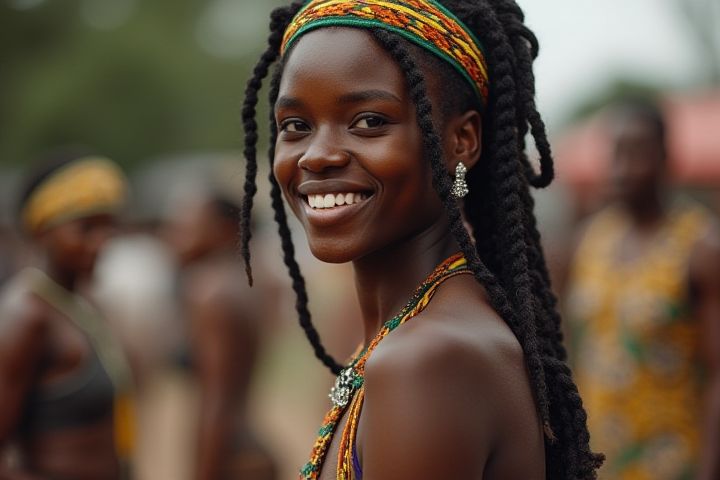
Nigeria, the most populous country in Africa, boasts a diverse demographic landscape with over 200 ethnic groups, with the Hausa, Yoruba, and Igbo being the largest. As of 2023, Nigeria's population exceeds 223 million people, with a youthful median age of approximately 18.5 years, indicating a vibrant workforce and significant potential for economic growth. The country's urbanization rate is accelerating, as cities like Lagos and Abuja draw millions seeking opportunities, leading to a dynamic shift in lifestyle and culture. Furthermore, Nigeria's official language is English, but numerous indigenous languages, such as Hausa, Yoruba, and Igbo, enrich daily communication and regional identity. This demographic richness contributes to Nigeria's intricate social fabric, making it a vital player in both regional and global contexts.
Young population
Nigeria boasts a youthful demographic landscape, with over 60% of its population under the age of 25. This vibrant segment not only drives cultural innovation but also plays a crucial role in the nation's economic development through entrepreneurship and technology. The burgeoning youth population presents both opportunities and challenges, as it necessitates an increased focus on education, job creation, and healthcare services. Harnessing the potential of this young workforce can significantly influence Nigeria's trajectory on the path to sustainable growth.
Rapid urbanization
Nigeria is experiencing rapid urbanization, with its urban population expected to exceed 200 million by 2040. Major cities like Lagos and Abuja are growing at unprecedented rates, attracting individuals seeking better job opportunities and living conditions. This demographic shift is accompanied by increased pressure on infrastructure, housing, and social services, making sustainable urban planning essential. Understanding these trends helps you appreciate the dynamic nature of Nigeria's demographic landscape and its implications for economic growth and development.
High ethnic diversity
Nigeria boasts one of the highest levels of ethnic diversity in Africa, with over 250 distinct ethnic groups, including the Hausa, Yoruba, and Igbo. This rich tapestry of cultures contributes to a vibrant mosaic of languages, customs, and traditions, making Nigeria a unique sociocultural landscape. The population is estimated at over 200 million people, reflecting significant growth and urbanization, particularly in major cities like Lagos and Abuja. Understanding this diversity is crucial for grasping Nigeria's complex social dynamics and economic potential.
Predominantly rural
Nigeria's demographics reveal a predominantly rural population, with approximately 50% of its citizens residing in rural areas as of 2023. This rural populace often relies on agriculture, which accounts for a significant portion of the nation's economy and sustains millions of families. The distribution of people across various ethnic groups, such as Hausa, Yoruba, and Igbo, influences local cultures, languages, and traditions unique to each region. Understanding these demographic patterns can help you appreciate the diverse socio-economic landscape of Nigeria.
Varied religious practices
Nigeria is a nation characterized by immense religious diversity, primarily divided among Islam, Christianity, and indigenous African beliefs. The northern region predominantly practices Islam, with various sects such as Sunni and Shia contributing to the rich tapestry of faith. In contrast, southern Nigeria is largely Christian, with denominations ranging from Catholicism to Pentecostalism, each influencing local culture and traditions. Understanding these demographics is essential for appreciating Nigeria's complex social dynamics and the interplay between religion, politics, and community life.
Gender imbalance
Nigerian demographics reveal a significant gender imbalance, with a notable disparity in the male-to-female ratio. Recent data indicates that males outnumber females, particularly in certain regions, exacerbated by cultural practices and socio-economic factors. This imbalance affects various sectors, including education and employment, where women often face limited opportunities. Understanding this demographic trend is crucial for formulating policies aimed at achieving gender equality and empowering women across Nigeria.
Growing middle class
Nigeria's demographics reveal a rapidly expanding middle class, a key driver of economic growth and consumption patterns. This emerging demographic, estimated to be over 40 million in size, influences various sectors, including retail, technology, and real estate. Characterized by increased disposable income and changing lifestyles, the middle class is contributing to a shift in consumer behavior towards branded goods and quality services. Your understanding of this trend is crucial for businesses seeking to tap into new markets and adapt to evolving consumer needs in Nigeria.
High fertility rate
Nigeria exhibits one of the highest fertility rates globally, averaging around 5.3 births per woman as of 2023. This high fertility contributes to a rapidly growing population, projected to exceed 400 million by 2050. The demographic profile reflects significant youthfulness, with approximately 43% of the population under the age of 15, creating a potential workforce for the future. These demographic trends present both challenges and opportunities for economic development, healthcare, and education in Nigeria.
Large diaspora
Nigeria boasts one of the largest diasporas in the world, with millions of Nigerians residing in countries across Africa, Europe, the Americas, and Asia. This vibrant community plays a crucial role in the nation's economy, contributing significantly through remittances, which surpassed $20 billion annually, underscoring their economic impact. The diaspora also serves as a bridge for cultural exchange, fostering international relationships and promoting Nigerian art, music, and traditions globally. You can explore how this extensive network enhances Nigeria's global standing and influences its development.
Increasing literacy rates
Nigeria's population, over 200 million, is characterized by a diverse array of ethnic groups and languages, which influences its education system. The government aims to enhance literacy rates, currently around 62%, by implementing various educational reforms and initiatives, including free universal primary education. In rural areas, challenges such as limited access to educational resources and socio-economic factors hinder progress and exacerbate inequality. Your involvement in community education programs can contribute significantly to bridging these gaps, fostering a more literate and informed society.
